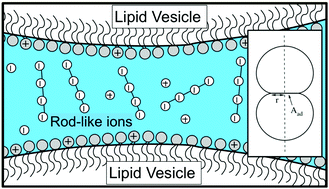Adhesion of like-charged lipid vesicles induced by rod-like counterions
Abstract
Adhesion of electrically charged lipid vesicles and subsequent formation of multi-vesicle aggregates can be induced by multivalent rod-like counterions. Motivated by recent experimental observations we calculate the equilibrium conformation of two identical vesicles that adhere onto each other. The degree of adhesion reflects the competition between predominantly electrostatic attraction and vesicle bending. Our model assumes the enclosed vesicle volume is allowed to freely adjust and the area of the vesicle membrane is fixed and remains constant. We describe the electrostatic attraction, which arises from the bridging of the rod-like counterions between the two like-charged vesicles, using a recently developed mean-field theory. Bending fluctuation-induced entropic repulsion, depletion forces between the apposed vesicle membranes induced by the rod-like counterions, and van der Waals attraction between the vesicles are estimated to induce only minor shifts in the equilibrium vesicle conformation. Our model predicts the dependence of vesicle adhesion (including its onset) exclusively from material or molecular parameters such as vesicle size and charge, bending stiffness of the membrane, effective length and net charge of the added rod-like counterions, as well as concentrations of rod-like counterions and additional salt content. We demonstrate that the demixing of charged lipids between the adhesion region and the uncomplexed parts of the vesicles has only a minor influence on the degree of adhesion. Our predictions are in qualitative agreement with recent experimental findings.



 Please wait while we load your content...
Please wait while we load your content...